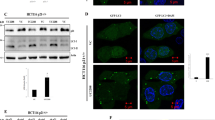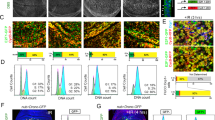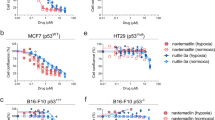Abstract
p21Waf1/Cip1 is a p53 transcription target implicated in both major functions of the tumor suppressor—cell cycle arrest and apoptosis. It is a potent inhibitor of the key cyclin-dependent kinases (CDK1–4), and has been thought to be the main mediator of p53-dependent G1 and G2 arrest. However, an increasing body of information suggests that in addition to its cell-cycle inhibitory activity, p21 can affect p53-dependent apoptosis. These data have been obtained from experiments in which p53 is activated primarily by genotoxic stress. In this study, we use the selective MDM2 antagonist, nutlin-3a, as a nongenotoxic p53 activator and show that the cell-cycle arrest function of p21 is dependent on the cellular context. In most cancer cell lines, p53-dependent p21 induction is essential for cell-cycle arrest, but in some, p21 is dispensable. Depletion of p21 did not increase the apoptotic response to nutlin-3a in all seven cancer cell lines tested and p21 overexpression did not protect apoptosis-sensitive lines from death. p21 was found to mediate nutlin-induced p53-dependent downregulation of another antiapoptotic protein, survivin, without significantly affecting the apoptotic outcome. Taken together our results suggest that p21 induction does not affect the apoptotic response to nongenotoxic p53 activation.
This is a preview of subscription content, access via your institution
Access options
Subscribe to this journal
Receive 50 print issues and online access
$259.00 per year
only $5.18 per issue
Buy this article
- Purchase on SpringerLink
- Instant access to full article PDF
Prices may be subject to local taxes which are calculated during checkout





Similar content being viewed by others
References
Abbas T, Dutta A . (2009). p21 in cancer: intricate networks and multiple activities. Nat Rev Cancer 9: 400–414.
Altieri DC . (2003). Survivin in apoptosis control and cell cycle regulation in cancer. Prog Cell Cycle Res 5: 447–452.
Altieri DC . (2008). New wirings in the survivin networks. Oncogene 27: 6276–6284.
Asada M, Yamada T, Ichijo H, Delia D, Miyazono K, Fukumuro K et al. (1999). Apoptosis inhibitory activity of cytoplasmic p21(Cip1/WAF1) in monocytic differentiation. Embo J 18: 1223–1234.
Bissonnette N, Hunting DJ . (1998). p21-induced cycle arrest in G1 protects cells from apoptosis induced by UV-irradiation or RNA polymerase II blockage. Oncogene 16: 3461–3469.
Brown CJ, Lain S, Verma CS, Fersht AR, Lane DP . (2009). Awakening guardian angels: drugging the p53 pathway. Nat Rev Cancer 9: 862–873.
Bunz F, Hwang PM, Torrance C, Waldman T, Zhang Y, Dillehay L et al. (1999). Disruption of p53 in human cancer cells alters the responses to therapeutic agents. J Clin Invest 104: 263–269.
Carvalho A, Carmena M, Sambade C, Earnshaw WC, Wheatley SP . (2003). Survivin is required for stable checkpoint activation in taxol-treated HeLa cells. J Cell Sci 116: 2987–2998.
Chan TA, Hwang PM, Hermeking H, Kinzler KW, Vogelstein B . (2000). Cooperative effects of genes controlling the G(2)/M checkpoint. Genes Dev 14: 1584–1588.
Dohi T, Beltrami E, Wall NR, Plescia J, Altieri DC . (2004). Mitochondrial survivin inhibits apoptosis and promotes tumorigenesis. J Clin Invest 114: 1117–1127.
Dohi T, Xia F, Altieri DC . (2007). Compartmentalized phosphorylation of IAP by protein kinase A regulates cytoprotection. Mol Cell 27: 17–28.
Dulic V, Stein GH, Far DF, Reed SI . (1998). Nuclear accumulation of p21Cip1 at the onset of mitosis: a role at the G2/M-phase transition. Mol Cell Biol 18: 546–557.
el-Deiry WS, Tokino T, Velculescu VE, Levy DB, Parsons R, Trent JM et al. (1993). WAF1, a potential mediator of p53 tumor suppression. Cell 75: 817–825.
Enge M, Bao W, Hedstrom E, Jackson SP, Moumen A, Selivanova G . (2009). MDM2-dependent downregulation of p21 and hnRNP K provides a switch between apoptosis and growth arrest induced by pharmacologically activated p53. Cancer Cell 15: 171–183.
Ferrandiz N, Martin-Perez J, Blanco R, Donertas D, Weber A, Eilers M et al. (2009). HCT116 cells deficient in p21(Waf1) are hypersensitive to tyrosine kinase inhibitors and adriamycin through a mechanism unrelated to p21 and dependent on p53. DNA Repair (Amst) 8: 390–399.
Gartel AL, Tyner AL . (1999). Transcriptional regulation of the p21((WAF1/CIP1)) gene. Exp Cell Res 246: 280–289.
Gartel AL, Tyner AL . (2002). The role of the cyclin-dependent kinase inhibitor p21 in apoptosis. Mol Cancer Ther 1: 639–649.
Harper JW, Adami GR, Wei N, Keyomarsi K, Elledge SJ . (1993). The p21 Cdk-interacting protein Cip1 is a potent inhibitor of G1 cyclin-dependent kinases. Cell 75: 805–816.
Harris SL, Levine AJ . (2005). The p53 pathway: positive and negative feedback loops. Oncogene 24: 2899–2908.
Hoffman WH, Biade S, Zilfou JT, Chen J, Murphy M . (2002). Transcriptional repression of the anti-apoptotic survivin gene by wild type p53. J Biol Chem 277: 3247–3257.
Huang S, Shu L, Dilling MB, Easton J, Harwood FC, Ichijo H et al. (2003). Sustained activation of the JNK cascade and rapamycin-induced apoptosis are suppressed by p53/p21(Cip1). Mol Cell 11: 1491–1501.
Janicke RU, Sohn D, Essmann F, Schulze-Osthoff K . (2007). The multiple battles fought by anti-apoptotic p21. Cell Cycle 6: 407–413.
Kokontis JM, Wagner AJ, O'Leary M, Liao S, Hay N . (2001). A transcriptional activation function of p53 is dispensable for and inhibitory of its apoptotic function. Oncogene 20: 659–668.
Lens SM, Wolthuis RM, Klompmaker R, Kauw J, Agami R, Brummelkamp T et al. (2003). Survivin is required for a sustained spindle checkpoint arrest in response to lack of tension. EMBO J 22: 2934–2947.
Levkau B, Koyama H, Raines EW, Clurman BE, Herren B, Orth K et al. (1998). Cleavage of p21Cip1/Waf1 and p27Kip1 mediates apoptosis in endothelial cells through activation of Cdk2: role of a caspase cascade. Mol Cell 1: 553–563.
Li F, Ambrosini G, Chu EY, Plescia J, Tognin S, Marchisio PC et al. (1998). Control of apoptosis and mitotic spindle checkpoint by survivin. Nature 396: 580–584.
Lohr K, Moritz C, Contente A, Dobbelstein M . (2003). p21/CDKN1A mediates negative regulation of transcription by p53. J Biol Chem 278: 32507–32516.
Lu Y, Yamagishi N, Yagi T, Takebe H . (1998). Mutated p21(WAF1/CIP1/SDI1) lacking CDK-inhibitory activity fails to prevent apoptosis in human colorectal carcinoma cells. Oncogene 16: 705–712.
Perkins ND . (2002). Not just a CDK inhibitor: regulation of transcription by p21(WAF1/CIP1/SDI1). Cell Cycle 1: 39–41.
Qi G, Tuncel H, Aoki E, Tanaka S, Oka S, Kaneko I et al. (2009). Intracellular localization of survivin determines biological behavior in colorectal cancer. Oncol Rep 22: 557–562.
Seoane J, Le HV, Massague J . (2002). Myc suppression of the p21(Cip1) Cdk inhibitor influences the outcome of the p53 response to DNA damage. Nature 419: 729–734.
Sohn D, Essmann F, Schulze-Osthoff K, Janicke RU . (2006). p21 blocks irradiation-induced apoptosis downstream of mitochondria by inhibition of cyclin-dependent kinase-mediated caspase-9 activation. Cancer Res 66: 11254–11262.
Suzuki A, Tsutomi Y, Akahane K, Araki T, Miura M . (1998). Resistance to Fas-mediated apoptosis: activation of caspase 3 is regulated by cell cycle regulator p21WAF1 and IAP gene family ILP. Oncogene 17: 931–939.
Thompson T, Tovar C, Yang H, Carvajal D, Vu BT, Xu Q et al. (2004). Phosphorylation of p53 on key serines is dispensable for transcriptional activation and apoptosis. J Biol Chem 279: 53015–53022.
Tian H, Wittmack EK, Jorgensen TJ . (2000). p21WAF1/CIP1 antisense therapy radiosensitizes human colon cancer by converting growth arrest to apoptosis. Cancer Res 60: 679–684.
Tovar C, Rosinski J, Filipovic Z, Higgins B, Kolinsky K, Hilton H et al. (2006). Small-molecule MDM2 antagonists reveal aberrant p53 signaling in cancer: implications for therapy. Proc Natl Acad Sci USA 103: 1888–1893.
Vassilev LT, Vu BT, Graves B, Carvajal D, Podlaski F, Filipovic Z et al. (2004). In vivo activation of the p53 pathway by small-molecule antagonists of MDM2. Science 303: 844–848.
Vassilev LT . (2007). MDM2 inhibitors for cancer therapy. Trends Mol Med 13: 23–31.
Vogelstein B, Lane D, Levine AJ . (2000). Surfing the p53 network. Nature 408: 307–310.
Vousden KH, Lu X . (2002). Live or let die: the cell′s response to p53. Nat Rev Cancer 2: 594–604.
Xia M, Knezevic D, Tovar C, Huang B, Heimbrook DC, Vassilev LT . (2008). Elevated MDM2 boosts the apoptotic activity of p53-MDM2 binding inhibitors by facilitating MDMX degradation. Cell Cycle 7: 1604–1612.
Xiong Y, Hannon GJ, Zhang H, Casso D, Kobayashi R, Beach D . (1993). p21 is a universal inhibitor of cyclin kinases. Nature 366: 701–704.
Yang H, Filipovic Z, Brown D, Breit SN, Vassilev LT . (2003). Macrophage inhibitory cytokine-1: a novel biomarker for p53 pathway activation. Mol Cancer Ther 2: 1023–1029.
Zhang Y, Fujita N, Tsuruo T . (1999). Caspase-mediated cleavage of p21Waf1/Cip1 converts cancer cells from growth arrest to undergoing apoptosis. Oncogene 18: 1131–1138.
Author information
Authors and Affiliations
Corresponding author
Ethics declarations
Competing interests
The authors declare no conflict of interest.
Additional information
Supplementary Information accompanies the paper on the Oncogene website
Supplementary information
Rights and permissions
About this article
Cite this article
Xia, M., Knezevic, D. & Vassilev, L. p21 does not protect cancer cells from apoptosis induced by nongenotoxic p53 activation. Oncogene 30, 346–355 (2011). https://doi.org/10.1038/onc.2010.413
Received:
Revised:
Accepted:
Published:
Issue date:
DOI: https://doi.org/10.1038/onc.2010.413
Keywords
This article is cited by
-
Biology of the cell cycle inhibitor p21CDKN1A: molecular mechanisms and relevance in chemical toxicology
Archives of Toxicology (2015)
-
Incompatible effects of p53 and HDAC inhibition on p21 expression and cell cycle progression
Cell Death & Disease (2013)
-
A threshold mechanism mediates p53 cell fate decision between growth arrest and apoptosis
Cell Death & Differentiation (2013)
-
Che-ating death: CHE1/AATF protects from p53-mediated apoptosis
The EMBO Journal (2012)
-
Disruption of the MDM2–p53 interaction strongly potentiates p53-dependent apoptosis in cisplatin-resistant human testicular carcinoma cells via the Fas/FasL pathway
Cell Death & Disease (2011)



